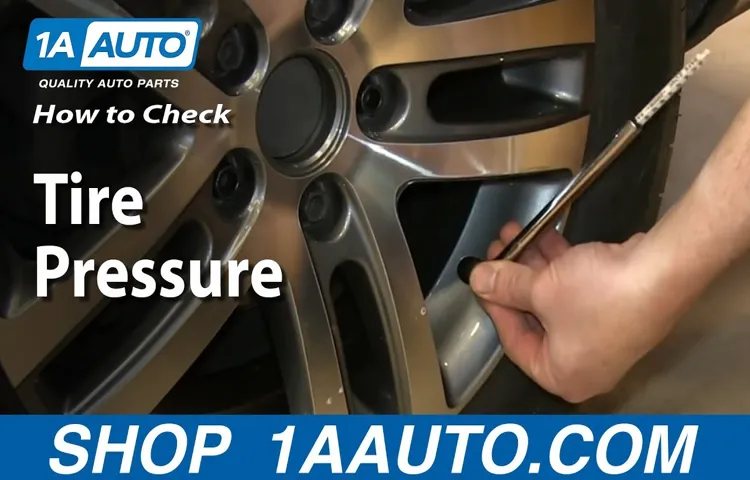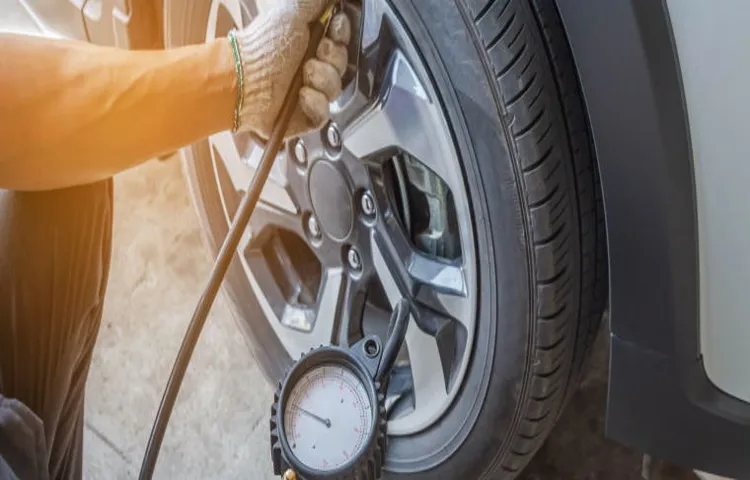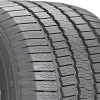Have you ever wondered why the recommended tire pressure on your car’s manual is not the same as what’s written on the tire sidewall? Or maybe you’re guilty of neglecting your tires until they appear visibly low or until you hear that telltale thud-thud-thud of a under-inflated tire on the road? Well, my friend, welcome to the science of tire inflation. This topic may not seem like the most exciting thing in the world but understanding the importance of proper tire pressure and how it affects your vehicle’s performance could save you money, keep you safe, and even help reduce your carbon footprint. To understand tire inflation, we must first understand tire pressure.
Every tire has a recommended pressure determined by the manufacturer based on several parameters like the vehicle’s weight, speed rating, and tire size. Proper inflation keeps the tire’s shape and maximizes the contact patch on the road, which provides better traction, handling, and fuel efficiency. Overinflation causes the tire’s center to bulge, causing uneven tire wear, while underinflation causes the sidewalls to bulge, which increases rolling resistance and generates heat, leading to tire failure.
So, how often should you check your tire pressure? The answer varies depending on several factors like the vehicle usage, weather conditions, and tire age. However, as a rule of thumb, you should check your tire pressure at least once a month and before long trips. In conclusion, taking care of your tires might not be the most exciting part of car ownership, but it’s also an important aspect that shouldn’t be overlooked.
Knowing the science behind tire inflation and maintaining proper pressure could save you money, prolong your tire’s lifespan, and keep you safe on the road.
Table of Contents
What is the Recommended Tire Pressure?
Have you ever noticed that tire shops tend to overinflate tires? It’s not uncommon for them to exceed the recommended tire pressure, but why do they do it? One reason could be that they want to ensure the tires maintain optimal pressure even as they naturally lose a few pounds of pressure over time. However, this approach can be problematic and lead to premature wear and tear on your tires. Overinflated tires can also cause a harsh ride, reduced traction, and increased risk of a blowout.
It’s crucial to follow the manufacturer’s recommended tire pressure, which can be found in the owner’s manual or on a placard on the driver’s side door jamb. The recommended tire pressure is designed to provide the best balance between handling, fuel efficiency, and tire wear. So, the next time you visit a tire shop, don’t be afraid to ask for the recommended tire pressure and ensure they adhere to it.
Determining Your Vehicle’s Correct Tire Pressure
When it comes to maintaining your vehicle, determining the correct tire pressure is crucial. The recommended tire pressure for your vehicle can typically be found on the driver’s side door jamb or in your owner’s manual. It’s important to note that the recommended tire pressure may differ for the front and rear tires, as well as for different driving conditions, such as highway driving or carrying heavy loads.
Keeping your tires inflated to the proper pressure can help improve fuel efficiency, extend the life of your tires, and provide better handling and safety on the road. So take a moment to check your tire pressure regularly and make sure you’re keeping your vehicle’s tires in tip-top shape!

The Reasons for Over-Inflation
Have you ever wondered why tire shops tend to overinflate your tires? Well, there are several reasons as to why this happens. One of the main reasons is that overinflated tires look more appealing to customers. This is because overinflated tires appear fuller and firmer than properly inflated tires.
Additionally, overinflated tires tend to provide better gas mileage, which is something many customers look for in their vehicles. However, this comes at a cost as overinflation can cause uneven wear on your tires, leading to a shorter tire lifespan. Overinflation can also cause a harsher ride, making the driving experience uncomfortable.
Therefore, it’s essential to ensure that your tires are properly inflated to prevent these issues.
Increases Tire Lifespan
Over-inflation is a common mistake that car owners make when trying to improve their tire’s lifespan. However, this approach can lead to more harm than good. One of the reasons for over-inflation is the misconception that it will make the tire last longer.
While it is true that properly inflated tires last longer, over-inflating tires can cause them to wear out much faster. This is because over-inflated tires have less contact with the road surface, causing uneven wear patterns. Additionally, over-inflated tires are more susceptible to punctures and blowouts, making them more dangerous to drive on.
Another reason for over-inflation is the belief that it will improve fuel efficiency. While it is true that properly inflated tires can increase fuel efficiency, over-inflating can actually decrease it. This is because over-inflated tires have a smaller contact patch, which means they have less grip on the road.
The tire will then need to work harder to maintain traction, leading to higher fuel consumption. In conclusion, while properly inflated tires can lead to improved lifespan and fuel efficiency, over-inflation can do more harm than good. It is important to follow the manufacturer’s recommended tire pressure and regularly check tire pressure to ensure safety and longevity.
By doing so, you can enjoy the benefits of a properly inflated tire without any negative consequences.
Improves Fuel Economy
Fuel Economy, Over-Inflation Over-inflation occurs when the pressure in your car tires exceeds the recommended level. While this may seem like a good idea for improving fuel economy, it can actually do more harm than good. Over-inflated tires can cause uneven wear, leading to decreased performance and safety issues.
Additionally, over-inflation can reduce the contact area between the tires and the road, resulting in less traction and stability. This can be particularly dangerous during wet or icy conditions, where grip is already compromised. It’s important to keep your tires at the recommended pressure levels to ensure optimal performance, fuel economy, and safety.
Check your owner’s manual or speak to a tire professional to determine the appropriate pressure level for your car. Taking a few extra minutes to ensure proper tire inflation can save you money in the long run and help protect you and your passengers.
Provides Better Handling
Over-inflation of tires can cause various issues, but one reason many people tend to overlook is the negative impact it has on handling. When tires are over-inflated, the contact area between the tire and the ground decreases, making it harder for the tire to grip the road. This can result in a bumpy and uncomfortable ride, especially on uneven surfaces.
Additionally, over-inflated tires can cause the vehicle to hydroplane in wet conditions, making it more difficult to brake and turn safely. All of these factors ultimately lead to a decrease in control and handling of the vehicle, which can be dangerous in certain driving situations. Therefore, it’s important to always check and maintain proper tire pressure levels to ensure optimal handling and safety on the road.
The Dangers of Under-Inflation vs Over-Inflation
Tire pressure is a critical factor to consider when maintaining your vehicle. It is essential to keep your tires inflated to the recommended level for optimal performance and safety. Over-inflating your tires can make them more prone to punctures and reduce traction, while under-inflated tires can cause excessive wear and tear, poor fuel economy, and even blowouts.
Some tire shops may overinflate your tires because they believe it could help your vehicle’s fuel economy or because it is easier to remove air rather than add it. However, this practice can cause more harm than good, and it is vital to ensure that your tires are inflated according to the manufacturer’s recommendations. Regular checks of your tire pressure can help you maintain your tires and prevent unnecessary wear and tear.
Remember, a quick pressure check can save you a lot of money in the long run, and prioritize safety over temporary gains.
Under-Inflation
Under-inflation is a serious issue that can put your safety on the line when driving. While many drivers are aware of the dangers of over-inflated tires, not many pause to consider the effects of under-inflation. Driving on under-inflated tires can lead to a number of problems, including decreased fuel efficiency, premature tire wear, and reduced handling and stability.
Moreover, under-inflation significantly increases the risk of a blowout while driving, which can be incredibly dangerous, particularly for high-speed vehicles. It’s essential to check your tires regularly to ensure they’re properly inflated, as this can not only extend the life of your tires but also keep you and others on the road safe.
Over-Inflation
Over-inflation is another common problem that can lead to dangerous driving conditions. When a tire is over-inflated, it becomes rigid and inflexible, meaning that it can’t absorb shock as effectively. This can lead to a rough ride and make it harder for the tire to maintain traction on the road.
Additionally, over-inflated tires are more likely to burst or fail, which can cause a serious accident. It’s important to follow the recommended tire pressure levels listed in your vehicle’s manual and to check your tire pressure regularly to avoid both over and under-inflation issues. Most cars have a tire pressure monitoring system that will alert you if your tires are over or under-inflated, so pay attention to these warnings and take action to adjust your tire pressure as needed.
By keeping your tires properly inflated, you can improve your safety on the road and extend the life of your tires.
Conclusion: The Importance of Proper Tire Inflation
Tire shops over inflate tires for a simple reason: to create a situation where their customers feel the need to come back sooner than necessary for another tire-related service. But let’s not throw the baby out with the bathwater – there are legitimate reasons to over inflate tires, such as improving mileage and grip on icy roads. So next time you’re at the tire shop, keep your eyes peeled for any tricks of the trade, and don’t be afraid to ask for the recommended tire pressure for your make and model.
Remember, proper tire care can lead to longer-lasting tires, reduced fuel consumption, and a safer ride. Stay inflated, fellow drivers!”
FAQs
What are the consequences of overinflating tires at tire shops?
Overinflating tires can cause uneven wear, decreased handling and stopping distances, and increased risk of a blowout.
How much overinflation is too much for tires?
Generally, any overinflation beyond the vehicle manufacturer’s recommended tire pressure can be considered too much.
Does overinflating tires save fuel?
While overinflation can theoretically improve fuel efficiency, the potential savings are usually negligible and do not justify the risks associated with overinflation.
How do I check my tire pressure to ensure it is not overinflated?
Use a quality tire pressure gauge and consult your vehicle’s owner manual or tire placard for the recommended pressure.
What can I do if I suspect my tires have been overinflated by a tire shop?
It’s important to safely release air from the tires to the correct pressure as soon as possible. If any damage or uneven wear has occurred, speak to a tire professional for advice.
Why do some tire shops overinflate tires?
Some tire shops may overinflate tires to compensate for small air leaks or to make the vehicle ride firmer, which can impact customer satisfaction.
What should I look for in a reputable tire shop to avoid overinflation issues?
Look for shops that prioritize proper tire pressure, follow manufacturer recommendations, and prioritize customer safety over quick fixes or shortcuts.



